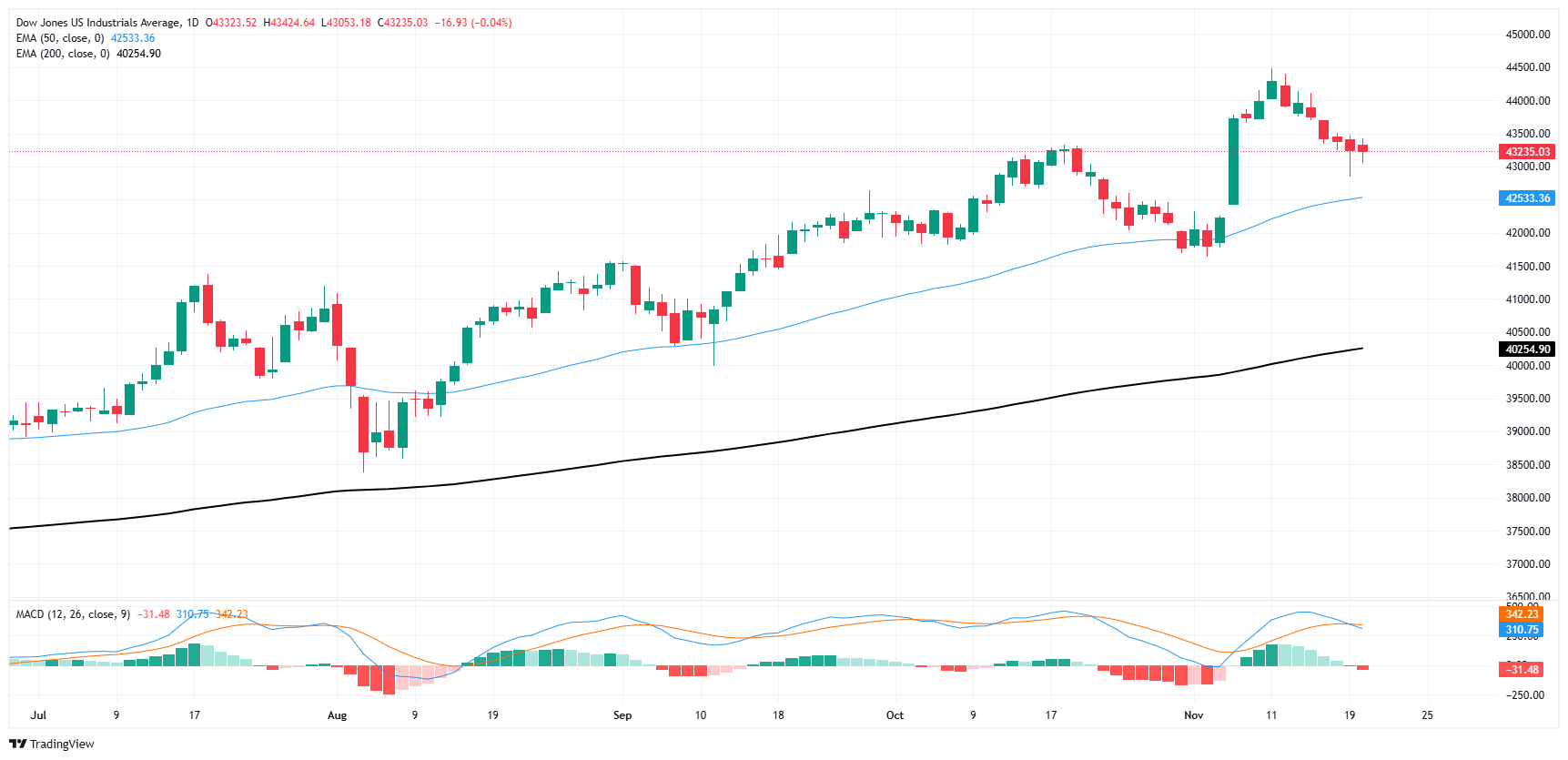Dow Jones Industrial Average wobbles ahead of key earnings on Wednesday

- The Dow Jones backslid another 150 points on Wednesday.
- Equity markets with little data to chew on are awaiting key earnings reports.
- Nvidia earnings are due after the closing bell, meaningful economic data starts Thursday.
The Dow Jones Industrial Average (DJIA) tested familiar lows on Wednesday, churning chart paper just north of the 43,000 handle. Markets are tepid as investors pull back slightly ahead of a key earnings report from major tech company Nvidia (NVDA) which is due after the bell, and a lack of meaningful economic figures throughout the front half of the trading week has left traders in the lurch.
Nvidia is expecting a bumper revenue posting late Wednesday after markets close. The company forecasts $32.5 billion in quarterly revenue thanks to a wide uptick in demand for its AI-focused Backwell GPU offerings. Nvidia has a tendency to outpace revenue expectations, with the chipmaker beating earnings calls ten out of the last 12 quarters.
The first half of the trading week was in a significant data drought with limited impactful US economic prints on the offering.Thursday will kick off the week’s useful, market-moving information with Initial Jobless Claims for the week ended November 15. Net new jobless benefits seekers are expected to number 220K on a weekly basis, up slightly from the previous week. The US Philadelphia Fed Manufacturing Survey is also due on Thursday, and is expected to ease back to 8.0 in November from the previous month’s 10.3.
The key data print this week will be S&P Purchasing Managers Index (PMI) survey results, which are due on Friday. Markets are anticipating a slight increase in Manufacturing PMI figures, expected to rise to 48.8 from the previous 48.5, while the Services component is expected to rise by a similar amount, to 55.3 from 55.0.
Dow Jones news
The Dow Jones is roughly on-balance for the day as investors await a reason to move. About half of the major equity index is stuck in the red on Wednesday, though Nvidia’s pre-earnings action is dragging the tech darling down a little more than usual, sending the DJIA into a lopsided stance.
Unitedhealth Group (UNH) rallied over 3% during the midweek market session, climbing towards $600 per share. Health insurance remains a popular choice among investors as healthcare costs spiral out of control in the US. On the low end, Nvidia has backslid around 1.8% ahead of its post-bell earnings call, falling into $144 per share.
Dow Jones price forecast
The Dow Jones Industrial Average is holding onto 43,200 for dear life as investors reject the idea of allowing price action to fall back below the 43,000 handle without a fight. The DJIA is down nearly 3% from all-time highs posted a little over a week ago just above 44,400.
Despite a near-term backslide, the Dow Jones is sitting better than pretty; the major equity index is still trading well north of the 50-day Exponential Moving Average (EMA) near 42,500, and it’s been nearly 13 months since the Dow Jones last kissed the 200-day EMA which is now rising into 40,250.
Dow Jones daily chart
Dow Jones FAQs
The Dow Jones Industrial Average, one of the oldest stock market indices in the world, is compiled of the 30 most traded stocks in the US. The index is price-weighted rather than weighted by capitalization. It is calculated by summing the prices of the constituent stocks and dividing them by a factor, currently 0.152. The index was founded by Charles Dow, who also founded the Wall Street Journal. In later years it has been criticized for not being broadly representative enough because it only tracks 30 conglomerates, unlike broader indices such as the S&P 500.
Many different factors drive the Dow Jones Industrial Average (DJIA). The aggregate performance of the component companies revealed in quarterly company earnings reports is the main one. US and global macroeconomic data also contributes as it impacts on investor sentiment. The level of interest rates, set by the Federal Reserve (Fed), also influences the DJIA as it affects the cost of credit, on which many corporations are heavily reliant. Therefore, inflation can be a major driver as well as other metrics which impact the Fed decisions.
Dow Theory is a method for identifying the primary trend of the stock market developed by Charles Dow. A key step is to compare the direction of the Dow Jones Industrial Average (DJIA) and the Dow Jones Transportation Average (DJTA) and only follow trends where both are moving in the same direction. Volume is a confirmatory criteria. The theory uses elements of peak and trough analysis. Dow’s theory posits three trend phases: accumulation, when smart money starts buying or selling; public participation, when the wider public joins in; and distribution, when the smart money exits.
There are a number of ways to trade the DJIA. One is to use ETFs which allow investors to trade the DJIA as a single security, rather than having to buy shares in all 30 constituent companies. A leading example is the SPDR Dow Jones Industrial Average ETF (DIA). DJIA futures contracts enable traders to speculate on the future value of the index and Options provide the right, but not the obligation, to buy or sell the index at a predetermined price in the future. Mutual funds enable investors to buy a share of a diversified portfolio of DJIA stocks thus providing exposure to the overall index.




